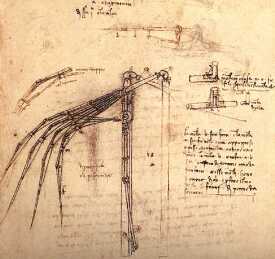|
ALAR (AY-luhr)
1.
Resembling or having wings
2.
A growth-regulating chemical sprayed on fruit trees
Common
clues: Banned apple spray; Having wings; Controversial orchard
spray; Winglike; Apple application, once; Wing-shaped; Apple
application, once
Crossword
puzzle frequency:
10 times a year
Frequency
in English language:
65750 / 86800
News:
Growers
convert more acres to organic
Video:
Hummingbirds
in slow motion

Leonardo
DaVinci’s “Mechanical Wing”
A
wing is a surface used to produce an aerodynamic force normal to
the direction of motion by traveling in air or another gaseous
medium, facilitating flight. It is a specific form of airfoil.
The first use of the word was for the foremost limbs of birds,
but has been extended to include the wings of insects, bats and
pterosaurs and also man-made devices.
A
wing is an extremely efficient device for generating lift. Its
aerodynamic quality, expressed as a Lift-to-drag ratio, can be up
to 60 on some gliders and even more. This means that a
significantly smaller thrust force can be applied to propel the
wing through the air in order to obtain a specified lift.
Daminozide
(trade name Alar) is a pesticide sprayed on apples to regulate
their growth, make their harvest easier, and enhance their color.
It was primarily used on apples, and was registered with the FDA
from 1963 to 1989 -- when it was banned in response to public
fears over a controversial study which found that Alar residue
could produce tumors in mice.
It is produced in the
U.S. by Uniroyal, which registered daminozide (or Alar) for use
on fruits intended for human consumption in 1963. In addition to
apples and ornamentals, it was also registered for use on
cherries, peaches, pears, Concord grapes, tomato transplants and
peanut vines. On fruit trees, daminozide affected flow-bud
initiation, fruit-set maturity, fruit firmness and coloring,
preharvest drop and market quality of fruit at harvest and during
storage.
In
1986, concern developed in the U.S. public over the use of Alar
on apples, over fears that the residues of the pesticide detected
in apple juice and applesauce might harm people. The outcry led
some manufacturers and supermarket chains to announce they would
not accept Alar-treated apples.
In
February, 1989 there was a broadcast by CBS's 60
Minutes highlighting
a report by the Natural Resources Defense Council claiming that
Alar was a dangerous carcinogen. In 1989, following the CBS
broadcast, the U.S. Environmental Protection Agency decided to
ban Alar on the grounds that "long-term exposure" posed
"unacceptable risks to public health."
Peter
Montague wrote:
"Laboratory
animals were exposed to high doses of Alar and UDMH, to see if
high doses would produce cancers. [Critics of the study argued
that] for humans to be exposed to equivalent high doses, they
would have to eat a box-car-load of apples each day." Apple
growers in Washington filed a libel suit against CBS, NRDC and
Fenton Communications, claiming the scare cost them $100M. The
suit was dismissed in 1994.
While
Alar has been verified as a human carcinogen, the amount
necessary for it to be dangerous may well be absurdly high. While
the lab tests that prompted the scare required an amount of Alar
equal to over 5000 gallons (20,000 L) of apple juice per day,
Consumers Union ran its own studies and estimated the human
lifetime cancer risk to be between 5 - 50 per million (1 case per
million is the threshold at which the government considers a
carcinogen a significant public health concern).
Elizabeth
Whelan and her organization, the American Council on Science and
Health (ACSH) worked to establish a narrative of the Alar episode
as a scare. The ACSH claimed that Alar and its breakdown product
UMDH had not been shown to be carcinogenic. Whelan's
campaign was so effective that today, Alar scare
is
shorthand among news media and food industry professionals for an
irrational, emotional public scare based on propaganda rather
than facts.
The
Alar scare also prompted the introduction of food libel laws in
13 states.
This
article is licensed under the GNU
Free Documentation License.
It uses material from the Wikipedia
article "Daminozide"and
“Wing”.
|